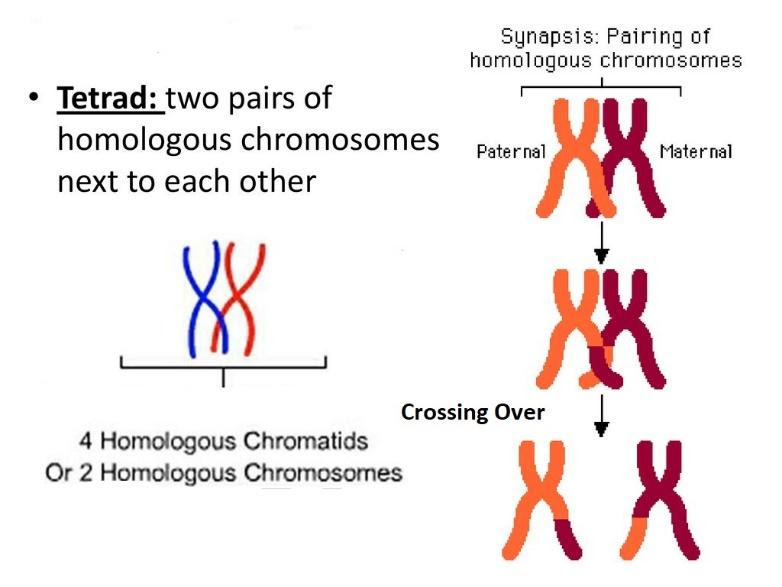
What are tetrads? Are they formed in mitosis?
Answer
472.5k+ views
Hint: Tetrads are a group of two homologous chromosomes, which come together undergoing the crossover event. Concerning homologous chromosomes, one homologous chromosome comes from the mother and the other one comes from the father. When they pair up for the preparation of crossing over events, they form a tetrad shape. As tetra stands for four, there are four sister chromatids.
Complete answer:

Fig.: Tetrads (Chromosomes)
In the interphase stage of meiosis, DNA has already been duplicated and condensed into chromosomes and each chromosome is composed of two identical sister chromatids. When a chromosome is paired with a similar chromosome, which is also made of two identical sister chromatids, the chromosomes become homologous.
Homologous chromosomes are similar, but not identical. This is similar to the case of human hair. Though the structure of the hair is the same for everyone, some people possess black hair, some have white hair, and some exhibit blonde hair.
A mitosis is a form of cell division, which is used for healing injuries in the body. In mitosis, a single parental cell divides to give two identical daughter cells. Tetrads do not appear in mitosis as there is no crossing-over event. Without crossing over, the chromosomes are brought to the equator of the cell in mitosis. There is no exchange of genetic information that takes place between the chromosomes.
In meiosis – I, the pairing of homologous chromosomes happens. Crossing over happens between homologous chromosomes and separation of homologous chromosomes occurs so that each daughter cell has one-half the chromosome number when compared to the parent cell. The tetrads are formed in the prophase stage of meiosis –I.
Note:
Tetrads are also called bivalents. For the crossing over to occur, the presence of tetrads is mandatory. When the separation of homologous chromosomes takes place in meiosis –I, the tetrads break apart. They are held together at a point known as chiasmata. Tetrads are attached to microtubules from the poles, with one homologous chromosome facing each pole at the end of the prophase – I stage.
Complete answer:

Fig.: Tetrads (Chromosomes)
In the interphase stage of meiosis, DNA has already been duplicated and condensed into chromosomes and each chromosome is composed of two identical sister chromatids. When a chromosome is paired with a similar chromosome, which is also made of two identical sister chromatids, the chromosomes become homologous.
Homologous chromosomes are similar, but not identical. This is similar to the case of human hair. Though the structure of the hair is the same for everyone, some people possess black hair, some have white hair, and some exhibit blonde hair.
A mitosis is a form of cell division, which is used for healing injuries in the body. In mitosis, a single parental cell divides to give two identical daughter cells. Tetrads do not appear in mitosis as there is no crossing-over event. Without crossing over, the chromosomes are brought to the equator of the cell in mitosis. There is no exchange of genetic information that takes place between the chromosomes.
In meiosis – I, the pairing of homologous chromosomes happens. Crossing over happens between homologous chromosomes and separation of homologous chromosomes occurs so that each daughter cell has one-half the chromosome number when compared to the parent cell. The tetrads are formed in the prophase stage of meiosis –I.
Note:
Tetrads are also called bivalents. For the crossing over to occur, the presence of tetrads is mandatory. When the separation of homologous chromosomes takes place in meiosis –I, the tetrads break apart. They are held together at a point known as chiasmata. Tetrads are attached to microtubules from the poles, with one homologous chromosome facing each pole at the end of the prophase – I stage.
Recently Updated Pages
The number of solutions in x in 02pi for which sqrt class 12 maths CBSE

Write any two methods of preparation of phenol Give class 12 chemistry CBSE

Differentiate between action potential and resting class 12 biology CBSE

Two plane mirrors arranged at right angles to each class 12 physics CBSE

Which of the following molecules is are chiral A I class 12 chemistry CBSE

Name different types of neurons and give one function class 12 biology CBSE

Trending doubts
One Metric ton is equal to kg A 10000 B 1000 C 100 class 11 physics CBSE

What is 1s 2s 2p 3s 3p class 11 chemistry CBSE

Discuss the various forms of bacteria class 11 biology CBSE

State the laws of reflection of light

Explain zero factorial class 11 maths CBSE

An example of chemosynthetic bacteria is A E coli B class 11 biology CBSE




